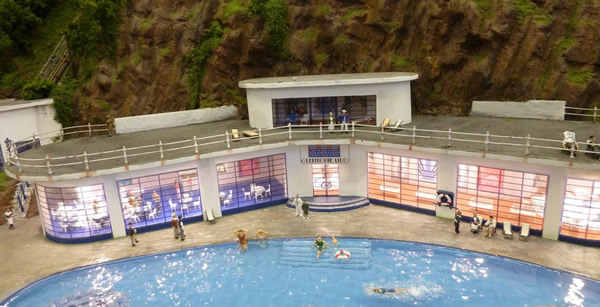|
the art of making model buildings


Building styles are very specific to an area
and the epoch. Even more special is railway architecture which was usually
standardised by railway companies. Understanding these architectural
nuances will result in a layout that looks authentic.

Gordon and Maggie
Gravett's 'Pempoul'. Even the concrete fencing is correct for the Reseau
Breton

Lynton station in 'L&B
Nuremburg style' 009 by Jeremy Reed
Early commercially available model buildings
did leave a great deal to be desired.

Hornby Dublo signal box
in die cast metal
Detail became better with the use of
plastics, as this Triang station shows.

In the late 1950s, printed card sheets were
produced by Builteze. Many of us can still remember spending pleasurable
hours cutting them out and gluing them together. The range was extensive
and is still available from Freestone Models. The modern counterpart is a
range supplied by Metcalfe Models. The sheets are pre-cut and the printing
quality is excellent. The lack of any relief is very noticeable in 00
scale but is often quite satisfactory in N scale.

Gradually better plastic buildings became
available but by then, many of us had read the wonderful books by John
Ahern and had begun to scratch build. His Madder Valley layout inspired us
all and luckily it is still preserved at the Pendon Museum.

The next step came from the United States.
Specialists began to supply kits in cast plaster (called Hydrocal), bass
wood (a very fine grain timber) and metal castings. Although these kits
are quite expensive, they just get better and better thanks to new
technologies such as laser cutting. Actually, you hardly have to scratch
build anything if you work in H0 or 1/4" scales. It is all available and
near perfect .............. at a price.

Europe is a far bigger market than the UK and
these days, some wonderful structures are available off the shelf from
companies such as Faller, Auhagen and Vollmer. When walking around
European model rail exhibitions, one does tend to see the same buildings
in use over and over again.

Back in the UK, about 50 years ago, Roye
England began to produce models that even today are some of the best in
the world. His work can be seen at the Pendon museum. Sadly, most of us do
not have such skills or the time to spend 2000 hours making one cottage!
It is probably true to say the we modellers have been trying to play
'catch up' with Roye ever since!

the work of Roye England

|